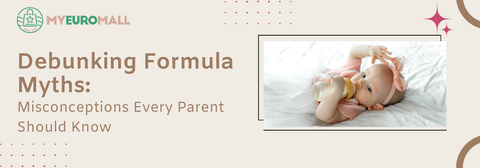Every parent wants to ensure they provide the best nutrition for their baby. With so many options on the market, understanding the differences between European infant formulas and those regulated by FDA approved standards can help you make an informed choice. In this guide, we’ll break down the key distinctions between EU standards and FDA regulations, explore why the best European baby formula brands are gaining popularity in the USA, and help you decide what’s best for your little one. For trusted European formulas, visit MyEuroMall.
Why Are EU Formulas Gaining Popularity in the USA?
In recent years, European infant formulas have seen a surge in demand among American parents, driven by their unique benefits:
● Organic Ingredients: Many of the best European baby formula brands prioritize organic farming practices, ensuring the ingredients are free from synthetic pesticides and fertilizers.
● No GMOs: European regulations prohibit using genetically modified organisms (GMOs) in infant formulas, giving parents peace of mind about what they’re feeding their babies.
● Probiotics and Prebiotics: EU formulas often include beneficial additives like probiotics and prebiotics, which support digestive health and immune function.
These benefits and the growing awareness of ingredient quality have made European infant formulas a top choice for health-conscious parents in the USA. Plus, parents can rest assured that these formulas are safe and suitable for American babies, as they meet stringent EU standards.
Regulatory Bodies: EFSA vs. FDA
To understand the differences between European infant formulas and those regulated by the FDA, it’s essential to look at the regulatory bodies behind them:
● EFSA (European Food Safety Authority): The EFSA oversees EU standards for infant formula, emphasizing the “Precautionary Principle.” This means that potential risks are addressed before a product reaches the market, ensuring high safety.
● FDA (U.S. Food and Drug Administration): The FDA takes a risk-based approach, focusing on addressing risks after they are identified. While both systems prioritize infant safety, their methods differ.
Neither approach is strictly “better” than the other—both aim to protect babies, but they do so through different regulatory philosophies.
Key Differences Between EU and FDA Standards
Ingredients
● EU Standards: European formulas emphasize natural, organic, and non-GMO ingredients. Additives like carrageenan are banned, and since 2020, all European infant formulas must include DHA (20mg/100kcal), an essential fatty acid for brain development.
● FDA Standards: The FDA allows more flexibility with ingredients, permitting additives like corn syrup solids, which are less common in EU formulas. While the FDA recommends DHA, it doesn’t require it.
Nutritional Requirements
● EU Standards: EU formulas prefer lactose as the primary carbohydrate source and typically contain lower iron levels, reflecting different nutritional philosophies (not safety concerns). They also have specific requirements for protein quality and quantity.
● FDA Standards: The FDA allows more flexibility in carbohydrate sources, such as corn syrup and sucrose, and doesn’t require lactose as the primary carbohydrate. Iron content guidelines also differ from those in the EU.
Safety Protocols
● EU Standards: The EU places a strong emphasis on pre-market approval, with rigorous testing protocols and specific thresholds for pesticide residues.
● FDA Standards: The FDA balances pre-market approval with post-market surveillance, relying on manufacturers to ensure safety under FDA oversight.
Labeling
● EU Standards: EU formulas provide detailed allergen information and use an age-based staging system (e.g., Stage PRE and 1: 0-6 months, Stage 2: 6-10 months, etc.). They also adhere to strict EU organic certification standards.
● FDA Standards: FDA-regulated formulas offer clear nutritional information but use a descriptive approach to stages (e.g., “infant formula” vs. “toddler formula”). Organic formulas are certified under USDA Organic standards.
HMOs (Human Milk Oligosaccharides) in Formula
Both the EU and the US allow (but do not require) the inclusion of HMOs in infant formula. HMOs are prebiotics found in human milk that support gut health and immunity. The EU approved specific HMOs (2′-FL and LNnT) in 2016, and many of the best European baby formula brands, such as HiPP, Holle, and Aptamil, now incorporate these beneficial components. Research shows that HMOs can help reduce infections and promote healthy digestion, making them a valuable addition to infant nutrition.
Why Do These Differences Matter for American Parents?
Understanding the differences between EU standards and FDA approved standards can help parents make informed choices. For example:
● European infant formulas may be the best choice if you prioritize organic, non-GMO ingredients.
● If you’re looking for formulas with mandatory DHA and no carrageenan, EU brands like HiPP, Holle, and Aptamil stand out.
● For parents concerned about digestive health, including probiotics and HMOs in many EU formulas can be a significant advantage.
Each brand offers unique benefits:
● HiPP known for its organic ingredients and added probiotics.
● Holle emphasizes biodynamic farming practices.
● Aptamil offers high-quality nutrition tailored to your baby’s needs.
These differences highlight why the best European baby formula brands are becoming a popular alternative for American families.
Conclusion
Choosing the right formula for your baby is a profoundly personal decision. Both EU standards and FDA approved standards ensure safety and quality, but they do so through different approaches. European infant formulas offer unique benefits like organic ingredients, no GMOs, and added probiotics, making them a compelling option for many parents.
If you’re considering the best European baby formula brands, explore trusted retailers like myeuromall to find formulas that meet your baby’s needs. With the right information, you can feel confident in making the best choice for your little one.
Subscribe to our newsletter for more tips, updates, and exclusive offers on European products. Stay informed and discover the best for your family!




